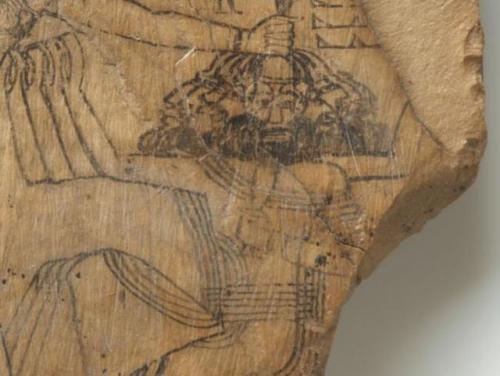egypt-museum:King Ramesses III Smiting his EnemiesThis ostracon depicts king Ramesses III wearing th
egypt-museum:King Ramesses III Smiting his EnemiesThis ostracon depicts king Ramesses III wearing the red crown of Lower Egypt smiting with his weapon foreign enemies whom he holds by the hair.On this ostracon, at the top right and below the royal cartouche of Ramesses III (r. ca. 1186-1155 BC), we read “He who crushes foreign lands and sacrifices chiefs”. Faithful to the conventions of the war stories of the Ramesside Period, the pharaoh represented conquered, in fact, by himself the innumerable crowd of enemies, gripping by the hair a bunch of Asiatics (recognizable by the code of racial stereotypes conveyed by the images Egyptians of the time: elongated beard, long hooked nose and receding forehead).The ostracon has a very balanced composition. The scene is structured with long red lines (red is the draft for the draftsman of ancient Egypt), one of which, essential, traces the diagonal of the arms of the king. The nine faces of the enemies (perhaps an echo of the “Nine Bows” designating the traditional enemies of Egypt) and the four arms, legs and torsos, suggest a group of prisoners facing the only victorious king. The details are drawn with a gesture of surprising firmness and regularity. The draftsman was probably based on a temple pylon relief that showed the king slaughtering enemies, defending Egypt against the forces of chaos that constantly threaten it.The ancient Egyptians drew on ostraca for a variety of reasons; for example, while planning work on tombs or as exercises. Ostraca are simple splinters of limestone or shards of pottery, on which the ancient Egyptians wrote or drew. This type of support was used because it was plentiful and of no material value, unlike papyrus, which was much more expensive.Some creations were simply the result of the draftsman’s imagination. Most of ostraca come from Deir el-Medina, the village of artisans employed in the construction of royal tombs and located on the west bank of Thebes.Now in the Art and History Museum, Brussels. E 7359 -- source link
Tumblr Blog : egypt-museum.com


